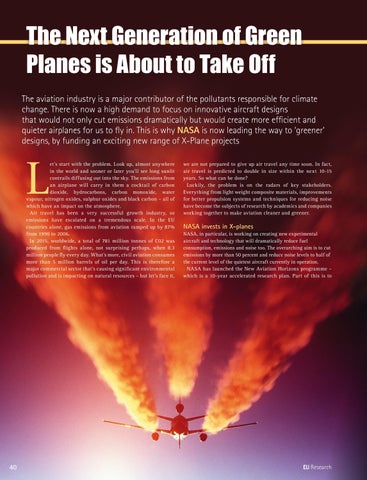The Next Generation of Green Planes is About to Take Off The aviation industry is a major contributor of the pollutants responsible for climate change. There is now a high demand to focus on innovative aircraft designs that would not only cut emissions dramatically but would create more efficient and quieter airplanes for us to fly in. This is why NASA is now leading the way to ‘greener’ designs, by funding an exciting new range of X-Plane projects
L
et’s start with the problem. Look up, almost anywhere in the world and sooner or later you’ll see long sunlit contrails diffusing out into the sky. The emissions from an airplane will carry in them a cocktail of carbon dioxide, hydrocarbons, carbon monoxide, water vapour, nitrogen oxides, sulphur oxides and black carbon – all of which have an impact on the atmosphere. Air travel has been a very successful growth industry, so emissions have escalated on a tremendous scale. In the EU countries alone, gas emissions from aviation ramped up by 87% from 1990 to 2006. In 2015, worldwide, a total of 781 million tonnes of C02 was produced from flights alone, not surprising perhaps, when 8.3 million people fly every day. What’s more, civil aviation consumes more than 5 million barrels of oil per day. This is therefore a major commercial sector that’s causing significant environmental pollution and is impacting on natural resources – but let’s face it,
40
we are not prepared to give up air travel any time soon. In fact, air travel is predicted to double in size within the next 10-15 years. So what can be done? Luckily, the problem is on the radars of key stakeholders. Everything from light weight composite materials, improvements for better propulsion systems and techniques for reducing noise have become the subjects of research by academics and companies working together to make aviation cleaner and greener.
NASA invests in X-planes NASA, in particular, is working on creating new experimental aircraft and technology that will dramatically reduce fuel consumption, emissions and noise too. The overarching aim is to cut emissions by more than 50 percent and reduce noise levels to half of the current level of the quietest aircraft currently in operation. NASA has launched the New Aviation Horizons programme – which is a 10-year accelerated research plan. Part of this is to
EU Research





















